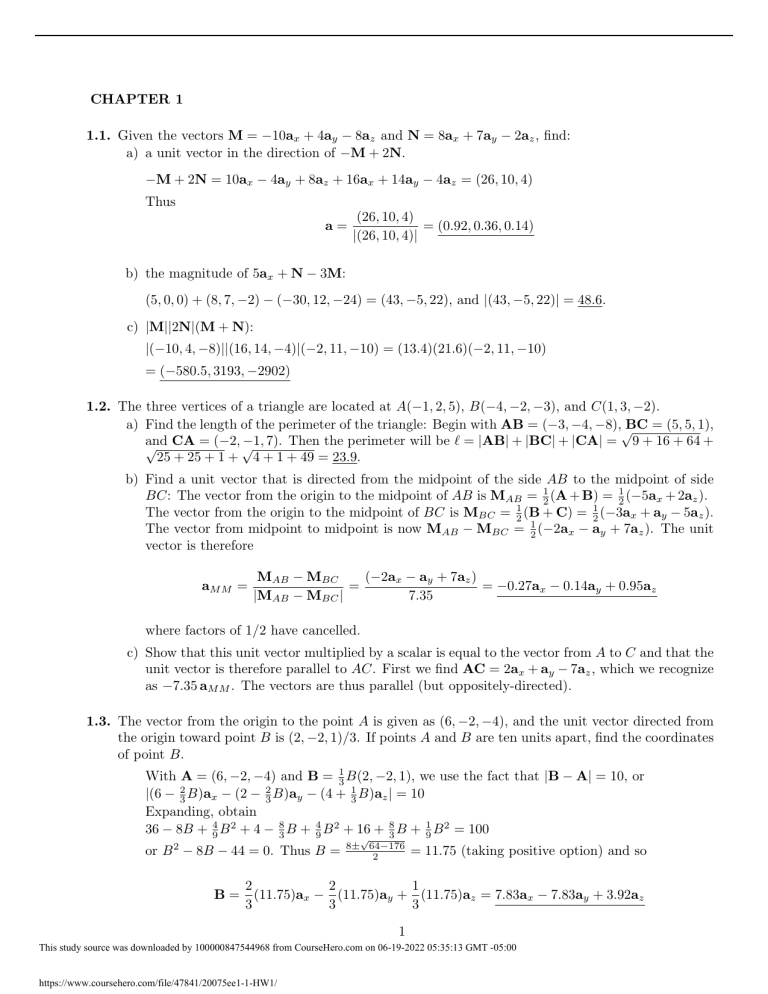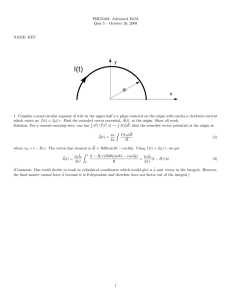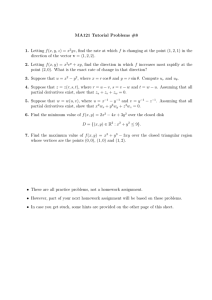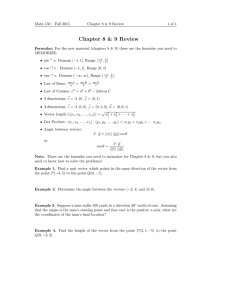
CHAPTER 1 1.1. Given the vectors M = −10ax + 4ay − 8az and N = 8ax + 7ay − 2az , find: a) a unit vector in the direction of −M + 2N. −M + 2N = 10ax − 4ay + 8az + 16ax + 14ay − 4az = (26, 10, 4) Thus a= (26, 10, 4) = (0.92, 0.36, 0.14) |(26, 10, 4)| b) the magnitude of 5ax + N − 3M: (5, 0, 0) + (8, 7, −2) − (−30, 12, −24) = (43, −5, 22), and |(43, −5, 22)| = 48.6. c) |M||2N|(M + N): |(−10, 4, −8)||(16, 14, −4)|(−2, 11, −10) = (13.4)(21.6)(−2, 11, −10) = (−580.5, 3193, −2902) 1.2. The three vertices of a triangle are located at A(−1, 2, 5), B(−4, −2, −3), and C(1, 3, −2). a) Find the length of the perimeter of the triangle: Begin with AB = (−3, −4, −8),√ BC = (5, 5, 1), 9 + 16 + 64 + and CA = (−2, −1, 7). Then the perimeter will be = |AB| + |BC| + |CA| = √ √ 25 + 25 + 1 + 4 + 1 + 49 = 23.9. b) Find a unit vector that is directed from the midpoint of the side AB to the midpoint of side BC: The vector from the origin to the midpoint of AB is MAB = 12 (A + B) = 12 (−5ax + 2az ). The vector from the origin to the midpoint of BC is MBC = 12 (B + C) = 12 (−3ax + ay − 5az ). The vector from midpoint to midpoint is now MAB − MBC = 12 (−2ax − ay + 7az ). The unit vector is therefore aM M = (−2ax − ay + 7az ) MAB − MBC = = −0.27ax − 0.14ay + 0.95az |MAB − MBC | 7.35 where factors of 1/2 have cancelled. c) Show that this unit vector multiplied by a scalar is equal to the vector from A to C and that the unit vector is therefore parallel to AC. First we find AC = 2ax + ay − 7az , which we recognize as −7.35 aM M . The vectors are thus parallel (but oppositely-directed). 1.3. The vector from the origin to the point A is given as (6, −2, −4), and the unit vector directed from the origin toward point B is (2, −2, 1)/3. If points A and B are ten units apart, find the coordinates of point B. With A = (6, −2, −4) and B = 13 B(2, −2, 1), we use the fact that |B − A| = 10, or |(6 − 23 B)ax − (2 − 23 B)ay − (4 + 13 B)az | = 10 Expanding, obtain 36 − 8B + 49 B 2 + 4 − 83 B + 49 B 2 + 16 + 83 B + 19 B 2 = 100 or B 2 − 8B − 44 = 0. Thus B = B= √ 8± 64−176 2 = 11.75 (taking positive option) and so 2 1 2 (11.75)ax − (11.75)ay + (11.75)az = 7.83ax − 7.83ay + 3.92az 3 3 3 1 This study source was downloaded by 100000847544968 from CourseHero.com on 06-19-2022 05:35:13 GMT -05:00 https://www.coursehero.com/file/47841/20075ee1-1-HW1/ 1.4. A circle, centered at the origin with a radius of 2 units, lies in the xy plane. Determine √ the unit vector in rectangular components that lies in the xy plane, is tangent to the circle at ( 3, 1, 0), and is in the general direction of increasing values of y: A unit vector tangent to this circle in the general increasing y direction is t = √ aφ . Its x and y aφ · ay = cos φ. At the point ( 3, 1), φ = 30◦ , components are tx = aφ · ax = − sin φ, and ty = √ and so t = − sin 30◦ ax + cos 30◦ ay = 0.5(−ax + 3ay ). 1.5. A vector field is specified as G = 24xyax + 12(x2 + 2)ay + 18z 2 az . Given two points, P (1, 2, −1) and Q(−2, 1, 3), find: a) G at P : G(1, 2, −1) = (48, 36, 18) b) a unit vector in the direction of G at Q: G(−2, 1, 3) = (−48, 72, 162), so aG = (−48, 72, 162) = (−0.26, 0.39, 0.88) |(−48, 72, 162)| c) a unit vector directed from Q toward P : aQP = P−Q (3, −1, 4) = (0.59, 0.20, −0.78) = √ |P − Q| 26 d) the equation of the surface on which |G| = 60: We write 60 = |(24xy, 12(x2 + 2), 18z 2 )|, or 10 = |(4xy, 2x2 + 4, 3z 2 )|, so the equation is 100 = 16x2 y 2 + 4x4 + 16x2 + 16 + 9z 4 1.6. If a is a unit vector in a given direction, B is a scalar constant, and r = xax + yay + zaz , describe the surface r · a = B. What is the relation between the the unit vector a and the scalar B to this surface? (HINT: Consider first a simple example with a = ax and B = 1, and then consider any a and B.): We could consider a general unit vector, a = A1 ax + A2 ay + A3 az , where A21 + A22 + A23 = 1. Then r · a = A1 x + A2 y + A3 z = f (x, y, z) = B. This is the equation of a planar surface, where f = B. The relation of a to the surface becomes clear in the special case in which a = ax . We obtain r · a = f (x) = x = B, where it is evident that a is a unit normal vector to the surface (as a look ahead (Chapter 4), note that taking the gradient of f gives a). 1.7. Given the vector field E = 4zy 2 cos 2xax + 2zy sin 2xay + y 2 sin 2xaz for the region |x|, |y|, and |z| less than 2, find: a) the surfaces on which Ey = 0. With Ey = 2zy sin 2x = 0, the surfaces are 1) the plane z = 0, with |x| < 2, |y| < 2; 2) the plane y = 0, with |x| < 2, |z| < 2; 3) the plane x = 0, with |y| < 2, |z| < 2; 4) the plane x = π/2, with |y| < 2, |z| < 2. b) the region in which Ey = Ez : This occurs when 2zy sin 2x = y 2 sin 2x, or on the plane 2z = y, with |x| < 2, |y| < 2, |z| < 1. c) the region in which E = 0: We would have Ex = Ey = Ez = 0, or zy 2 cos 2x = zy sin 2x = y 2 sin 2x = 0. This condition is met on the plane y = 0, with |x| < 2, |z| < 2. 2 This study source was downloaded by 100000847544968 from CourseHero.com on 06-19-2022 05:35:13 GMT -05:00 https://www.coursehero.com/file/47841/20075ee1-1-HW1/ 1.8. Demonstrate the ambiguity that results when the cross product is used to find the angle between two vectors by finding the angle between A = 3ax − 2ay + 4az and B = 2ax + ay − 2az . Does this ambiguity exist when the dot product is used? We use the relation A × B = |A||B| sin θn. With the given vectors we find √ 2ay + az √ √ √ A × B = 14ay + 7az = 7 5 = 9 + 4 + 16 4 + 1 + 4 sin θ n 5 ±n where n is identified as shown; we see that n can be positive or negative, as sin θ can be positive or negative. This apparent sign ambiguity is not the real problem, however, as we really want of the angle anyway. Choosing the positive sign, we are left with √ the √ magnitude √ sin θ = 7 5/( 29 9) = 0.969. Two values of θ (75.7◦ and 104.3◦ ) satisfy this equation, and hence the real ambiguity. √ In using the dot product, we find A · B = 6 − 2 − 8 = −4 = |A||B| cos θ = 3 29 cos θ, or √ cos θ = −4/(3 29) = −0.248 ⇒ θ = −75.7◦ . Again, the minus sign is not important, as we care only about the angle magnitude. The main point is that only one θ value results when using the dot product, so no ambiguity. 1.9. A field is given as G= (x2 25 (xax + yay ) + y2 ) Find: a) a unit vector in the direction of G at P (3, 4, −2): Have Gp = 25/(9 + 16) × (3, 4, 0) = 3ax + 4ay , and |Gp | = 5. Thus aG = (0.6, 0.8, 0). b) the angle between G and ax at P : The angle is found through aG · ax = cos θ. So cos θ = (0.6, 0.8, 0) · (1, 0, 0) = 0.6. Thus θ = 53◦ . c) the value of the following double integral on the plane y = 7: 4 2 G · ay dzdx 0 0 4 0 2 0 4 2 4 25 25 350 (xax + yay ) · ay dzdx = × 7 dzdx = dx 2 2 2 2 x +y 0 0 x + 49 0 x + 49 4 1 −1 tan − 0 = 26 = 350 × 7 7 1.10. By expressing diagonals as vectors and using the definition of the dot product, find the smaller angle between any two diagonals of a cube, where each diagonal connects diametrically opposite corners, and passes through the center of the cube: Assuming a side length, b, two diagonal vectors would be A = √ b(ax + √ ay + az ) and B = 2 b(ax − ay + az ). Now use A · B = |A||B| cos θ, or b (1 − 1 + 1) = ( 3b)( 3b) cos θ ⇒ cos θ = 1/3 ⇒ θ = 70.53◦ . This result (in magnitude) is the same for any two diagonal vectors. 3 This study source was downloaded by 100000847544968 from CourseHero.com on 06-19-2022 05:35:13 GMT -05:00 https://www.coursehero.com/file/47841/20075ee1-1-HW1/ Powered by TCPDF (www.tcpdf.org)






